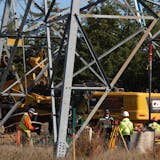The development of the former Ford property in St. Paul's Highland Park will include a contentious element — single-family houses along the Mississippi River.
The development's future became clearer Wednesday as the City Council voted 6-1 to change the area's master zoning plan to better align with what developer Ryan Companies said it can sell. That includes allowing up to 35 single-family houses among the 3,800 units of housing Ryan said will be built on the 122-acre site.
Council Member Rebecca Noecker was the dissenter. She said she appreciated the work that went into the plan, but she continues to think single-family houses should not be a part of the package.
"Especially with our affordable housing needs," she said. "I continue to believe we can have multifamily housing along the river."
Council Member Mitra Jalali Nelson, who voted against the amendments two weeks ago, voted in favor of the changes Wednesday. She said she "struggled a bit" with the single-family houses, as well as an increase in commercial parking at the site's northern edge, but in the end she decided "it was time to move forward."
She added: "Given the totality of the plan, I could not justify voting against the plan based on two things I disagreed with."
Council Member Chris Tolbert, who represents Highland Park and presented the amendments that Ryan officials had said they needed for the development's success, said the developer can still build multifamily housing along Mississippi River Boulevard.
"There's nothing that prohibits that," he said.


